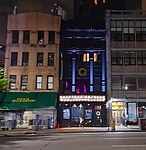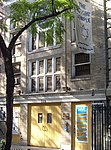47th Street Theatre
Fire stations in New York CityHell's Kitchen, ManhattanManhattan building and structure stubsNew York City Designated Landmarks in ManhattanOff-Broadway theaters ... and 2 more
Theatres in ManhattanUnited States theater (structure) stubs

47th Street Theatre is an Off Broadway theatre venue at 304 West 47th Street in New York City's Hell's Kitchen neighborhood. Built as Fire Engine Company No. 54 in 1888, it was designed by Napoleon LeBrun & Sons for the New York City Fire Department. It is a New York City designated landmark.The venue has been home to the Puerto Rican Traveling Theater, and in 2007 began showing productions of the Forbidden Broadway series of shows. In June 2017, Spamilton, a parody of the musical Hamilton moved to the theatre from the Triad Theatre.
Excerpt from the Wikipedia article 47th Street Theatre (License: CC BY-SA 3.0, Authors, Images).47th Street Theatre
West 47th Street, New York Manhattan
Geographical coordinates (GPS) Address Phone number Website Nearby Places Show on map
Geographical coordinates (GPS)
| Latitude | Longitude |
|---|---|
| N 40.7605 ° | E -73.9881 ° |
Address
Econo Lodge
West 47th Street 302
10036 New York, Manhattan
New York, United States
Open on Google Maps









